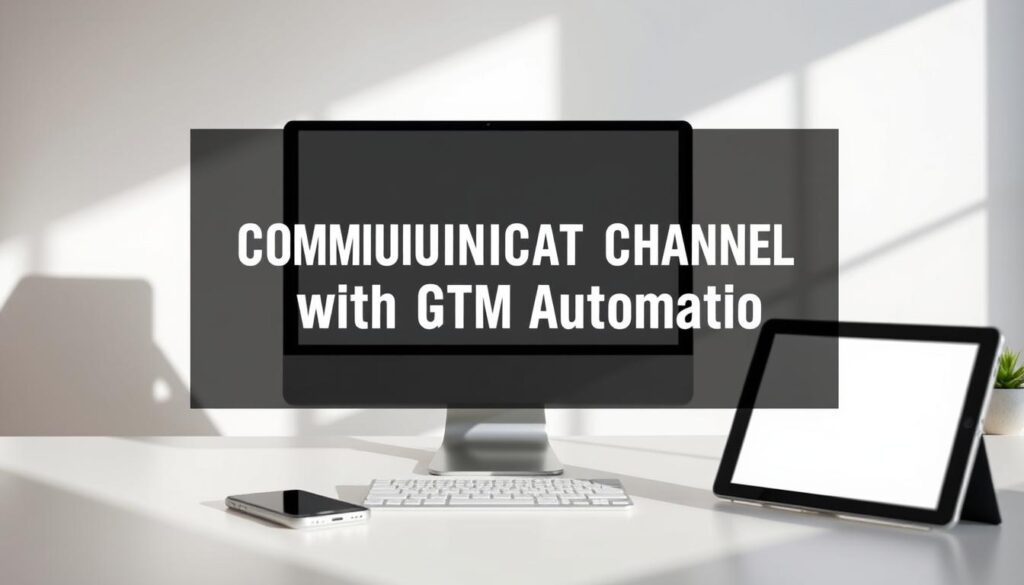In today’s fast world, using GTM automation to streamline communication is key for businesses wanting to do better. By using GTM automation, companies can cut down on unwanted chatter. This ensures important messages get to the right people when needed. GTM automation not just makes operations smooth but also helps in making quick decisions and working together better.
As companies deal with complex communication needs, having an effective automation plan is very important. This can play a huge role in how well a company performs.
Key Takeaways
- GTM automation enhances communication efficiency across organizations.
- Effective workflows can significantly reduce communication noise.
- Automation solutions support timely interactions with stakeholders.
- Implementing GTM can foster collaborative environments.
- Adopting GTM automation requires strategic planning.
Understanding GTM Automation and Its Importance
GTM automation is now key for businesses seeking top performance. It uses tools and strategies to make marketing and sales smoother. This helps companies connect with customers better and cuts down on waste.
What is GTM Automation?
GTM automation means using tech to make marketing and sales jobs automatic. This covers lead generation, reaching out to customers, and tracking outcomes. By using these tools, firms can improve their methods, ensure messages are sent on time, and use their resources well.
Benefits of Implementing GTM Automation
Putting in GTM automation brings many gains, especially in talking to customers. The main benefits are:
- Improved Engagement: Sending messages at the right time makes customers more interested. This can lead to more sales.
- Reduced Administrative Burdens: Automation takes over boring tasks. This lets teams work on bigger projects.
- Data-Driven Insights: Better analytics give valuable knowledge, which helps in making smart choices.
GTM automation also makes sure messages get to the intended audience when it should. This builds stronger connections with customers.
Common Misconceptions About GTM
Many think GTM automation makes customer talks feel cold. But, the truth is, good automation tools aim for personal touches in communication. They don’t reduce interaction quality. Instead, they help create engaging strategies that customers truly appreciate.
To wrap it up, getting GTM automation right means smoother operations and better relationships with customers.
| Benefits | Description |
|---|---|
| Improved Engagement | Increases conversion rates through timely outreach. |
| Reduced Administrative Burdens | Free up team resources by automating repetitive tasks. |
| Data-Driven Insights | Facilitates better decision-making with enhanced analytics. |
| Personalized Communication | Maintains engagement quality with tailored messaging. |
Key Features of GTM Automation for Communication
GTM automation changes how organizations talk to each other. It uses tools that help with speed and flexibility. There are big parts like integrating data in real time, automating regular jobs, and making workflows you can change. Each of these parts is key to making communication quicker through GTM automation. They also make communication smoother.
Real-time Data Integration
This feature lets groups get the latest info right away. This means they can quickly react to new market trends and what customers do. By using up-to-the-minute data, teams can make their messages fit what each person likes. This makes for a unified strategy that boosts efficient chatting through GTM automation.
Automation of Routine Tasks
Automating daily tasks saves a lot of time. Teams can then focus on more important talks instead of boring stuff. This helps them be more creative and think smartly. In the end, this makes everyone more productive and helps achieve smooth chatting through GTM automation.
Customizable Workflows
GTM automation gives you workflows that can change to fit what your group needs. This means teams can set up processes that match their specific goals, making things run smoother. These flexible workflows help teams work better together. They make sure messages are clear and ideas move without a hitch.

AI tools play a big role in making these features work well. They help organizations have a clear and united message. This leads to better teamwork and smarter choices. To learn more about how AI helps teams work together better, check out how AI impacts working together across different.
How GTM Automation Enhances Team Collaboration
Teamwork is key to reaching shared goals. GTM automation makes team communication better. It improves teamwork by making information sharing, project handling, and engagement easier.
Improved Information Sharing
GTM automation makes communication better by sharing information more easily. Teams can easily get real-time data, which helps everyone stay connected. This ensures all team members can make quick decisions, creating a stronger team.
Streamlined Project Management
Good project management helps meet deadlines and achieve goals. GTM automation makes assigning and tracking tasks simpler. It keeps teams updated, helping ensure everything gets done on time.
Fostering a Collaborative Environment
A good team environment needs good communication and sharing. GTM automation promotes sharing ideas and feedback. By using these tools, teams work better together and increase their productivity.
Best Practices for Adopting GTM Automation
Effectively adopting GTM automation means having a plan that ensures it works well from the start. Organizations should check their communication methods before anything else. This helps them see what’s working and where they can get better. They should set clear goals that are tied to how well the automation is working. And making sure their team knows how to use the new tools is key for smooth communication.
Assessing Your Current Communication Channels
Finding where your current communication falls short is important. An audit can show you where problems in collaboration and sharing information are. It helps to look at:
- Where communication gets stuck
- How well your current tools are working
- What your team thinks about how you talk to each other
Setting Clear Objectives
After checking your communication, set goals for what you want GTM automation to achieve. These goals should help steer your implementation and should connect with your bigger business aims. When making these goals, think about:
- What improvements you want in efficiency, engagement, or productivity.
- What numbers will show you’re succeeding.
- Keep checking on your goals and update them as you learn more and get feedback.
Training Your Team Effectively
Teaching your team well is crucial for GTM automation success. It’s important that everyone knows how to use the tools so they can engage and use them correctly. Focus your training on:
- Hands-on workshops that explain what the tools do.
- Continuous support for any questions or problems.
- Promoting ongoing learning to stay up-to-date with new tech.

To streamline communication, follow these best practices for bringing in GTM automation. Those looking to do even better can check out GTM automation solutions for streamlined communication. Starting with a good assessment, setting clear goals, and proper training sets you up for success.
Measuring the Impact of GTM Automation on Communication
To see if GTM automation makes our talks better, we check clear outcomes. We use Key Performance Indicators (KPIs) to watch how our chat and work get better. By looking at the numbers, we learn if making our chats smoother with GTM automation works well.
Key Performance Indicators (KPIs)
KPIs are our guide to see what matters in our talks. Here are some familiar ones:
- Response Times: Track how fast we answer people.
- Conversion Rates: See if our chats lead to action.
- User Engagement Statistics: Watch how people interact with our channels.
Tools for Data Analysis
To make sense of the data, we use cool tools. These help gather info and show us trends from using GTM automation to chat better. Here are tools that work great:
- Google Analytics: For tracking website engagement.
- Tableau: For visual data representation.
- Power BI: For interactive dashboard creation.
Continuous Improvement Strategies
Armed with data, we can tweak how we talk. We make it better by checking often and changing things based on what people say. Adding a way for feedback helps us make sure our tweaks are based on actual facts. This makes streamlining our talks with GTM automation really work.
| KPI | Measurement Method | Performance Goal |
|---|---|---|
| Response Times | Average response duration from inquiry to answer | Less than 2 hours |
| Conversion Rates | Percentage of inquiries that lead to desired actions | Above 25% |
| User Engagement Statistics | Tracking active user interactions across channels | Increased by 20% quarterly |
Future Trends in GTM Automation and Communication
The future of GTM automation is bright, with big changes coming. AI’s growth in automation will change how we communicate. Better personalization and predictive tools will help companies talk more effectively to their customers. This means using GTM automation to make sure messages hit the mark.
New tech like machine learning and big data will push things further. They’ll give deep insights into what customers do and want. With this information, companies can improve how they reach out. This makes GTM automation better at connecting with people and building a loyal customer group.
In the next five years, we’ll see a big move to very personalized ways of talking to customers. Old methods will fade as new, smarter ones take over. This will change how teams work together. Keeping up with these changes is key. Sites like this one are great for staying in the loop with GTM automation and communication trends.
FAQ
What is GTM Automation?
GTM Automation is about using tools and strategies to make marketing and sales processes easier. These tools help improve how we talk within companies.
What are the benefits of implementing GTM Automation?
GTM Automation makes it easier to reach out at the right time, lessens workloads, and lets us talk in a more personal way. It also makes managing communication simpler.
How does GTM Automation improve communication processes?
It makes communication better by using up-to-date data, handling everyday tasks automatically, and being adaptable to fit different organizations.
What are some common misconceptions about GTM Automation?
Some people think automation makes things less personal. But, getting it right means we can actually make our chats even more personal.
How does GTM Automation enhance team collaboration?
GTM Automation helps teams share info better with integrated systems, manage projects smoother, and encourages sharing ideas.
What are best practices for adopting GTM Automation?
To do it right, first see where communication can improve, set clear goals, and train your team well so everyone knows how to use these tools.
How can organizations measure the impact of GTM Automation on communication?
They can use Key Performance Indicators like how fast we respond, how well we turn leads into customers, and how engaged people are. Tools for analyzing data help make good choices.
What future trends can we expect in GTM Automation and communication?
We’ll see more AI and personalized messages, along with using machine learning and big data. Communications will focus more on the unique needs of each customer as their behaviors change.



